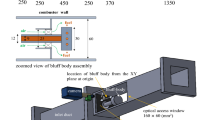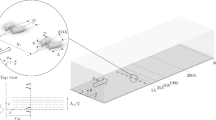Abstract
A finite reaction rate model is presented as a closure of large eddy simulation (LES) to numerically study an open premixed methane/air swirling flame. The resultant model is firstly validated by comparing with reported data and then employed to investigate the effect of swirling intensity on flow field, flame characteristics and combustion instability of the swirling flame. Three different swirl numbers are considered. The LES results show that as swirling intensity increases, the vortex entrainment and micro-mixing are enhanced, leading to more lean equivalent ratios at flame front; consequently, higher swirling number causes lower flame temperatures and slower CO oxidization; for all simulated swirl numbers, flame fronts are completely located out of the recirculation zones and anchored at the inner surface of the annular swirling steams; swirl number has a crucial effect on swirling flame extension toward radial and tangential dimensions and then significantly affects streamwise flame length, which is a great influencing factor on combustion instability; vortex-induced disturbance on flame in streamwise plays a critical role in combustion instability.









Similar content being viewed by others
References
Khelil A, Naji H, Loukarfi L et al (2009) Prediction of a high swirled natural gas diffusion flame using a PDF model. Fuel 88:374–381
Yang W, Zhang J (2009) Simulation of methane turbulent swirling flame in the TECFLAM combustor. Appl Math Model 33:2818–2830
Driscoll JF (2008) Turbulent premixed combustion: flamelet structure and its effect on turbulent burning velocities. Prog Energy Combust Sci 34:91–134
Chan CK, Lau KS, Chin WK et al (1992) Freely propagating open premixed turbulent flames stabilized by swirl. Proc Combust Inst 24:511–518
Ji J, Gore JP (2002) Flow structure in lean premixed swirling combustion. Proc Combust Inst 29:861–867
Syred N (2006) A review of oscillation mechanisms and the role of the precessing vortex core (PVC) in swirl combustion systems. Prog Energ Combust Sci 32:93–161
Ranga-Dinesh KKJ, Jenkins KW, Kirkpatrick MP et al (2010) Modelling of instabilities in turbulent swirling flames. Fuel 89:10–18
Schneider C, Dreizler A, Janicka J (2005) Fluid dynamical analysis of atmospheric reacting and isothermal swirling flows. Flow Turbul Combust 74:103–127
Galpin J, Naudin A, Vervisch L et al (2008) Large-eddy simulation of a fuel-lean premixed turbulent swirl-burner. Combust Flame 155:247–266
Freitag M, Janicka J (2007) Investigation of a strongly swirled unconfined premixed flame using LES. Proc Combust Inst 31:1477–1485
Huang Y, Yang V (2005) Effect of swirl on combustion dynamics in a lean-premixed swirl-stabilized combustor. Proc Combust Inst 30:1775–1782
Cheng RK, Yegian DT, Miyasato MM et al (2000) Scaling and development of low-swirl burners for low emission furnaces and boilers. Proc Combust Inst 28:1305–1313
Petersson P, Olofsson J, Brackman C et al (2007) Simultaneous PIV/OH-PLIF, Rayleigh thermometry/OH-PLIF and stereo PIV measurements in a low-swirl flame. Appl Opt 46:3928–3936
Zhao QW, Chan CK, Zhao HF (2004) Numerical simulation of open swirl-stabilized premixed combustion. Fuel 83:1615–1623
Lilly DK (1992) A proposed modification of the Germano subgrid-scale closure method. Phys Fluids 4:633–635
Fureby C (2007) Comparison of flamelet and finite rate chemistry LES for premixed turbulent combustion. 45th AIAA Aerospace Sciences Meeting and Exhibit, Reno, Nevada
Magnussen BF (1981) On the structure of turbulence and a generalized eddy dissipation concept for chemical reaction in turbulent flow. 19th AIAA Aerospace Science Meeting, St. Louis, MI
Launder BE, Spalding DB (1972) Mathematical models of turbulence. Academic Press, London
Nogenmyr K-J, Fureby C, Bai XS et al (2009) Large eddy simulation and laser diagnostic studies on a low swirl stratified premixed flame. Combust Flame 156:25–36
Kee RJ, Rupley FM, Miller JA (1989) Chemkin-II: a fortran chemical kinetics package for the analysis of gas-phase chemical kinetics. Report no. SAND89-8009, Sandia National Laboratories
Poinsot TJ, Lele SK (1992) Boundary conditions for direct simulations of compressible viscous flows. J Comput Phys 101:104–129
Zhou LX, Hu LY, Wang F (2008) Large-eddy simulation of turbulent combustion using different combustion models. Fuel 87:3123–3131
Loiseleux T, Chomaz JM, Huerre P (1998) The effect of swirl on jets and wakes: linear instability of the Rankine vortex with axial flow. Phys Fluids 10:1120–1134
Chakraborty N, Cant RS (2004) Unsteady effects of strain rate and curvature on turbulent premixed flames in an inflow-outflow configuration. Combust Flame 137:129–147
Hawkes ER, Chen JH (2004) Direct numerical simulation of hydrogen-enriched lean premixed methane-air flames. Combust Flame 138:242–258
Acknowledgments
This work was supported by the National Natural Science Foundation of China (51176169) and the National Basic Research Program of China (2012CB214906).
Author information
Authors and Affiliations
Corresponding author
About this article
Cite this article
Wang, Z., Xu, Y., Lü, Y. et al. LES investigation of swirl intensity effect on unconfined turbulent swirling premixed flame. Chin. Sci. Bull. 59, 4550–4558 (2014). https://doi.org/10.1007/s11434-014-0507-z
Received:
Accepted:
Published:
Issue Date:
DOI: https://doi.org/10.1007/s11434-014-0507-z




